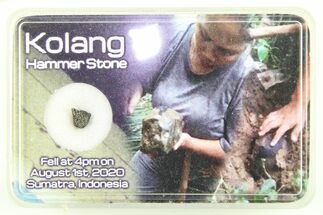.06" Orgueil Meteorite Fragment - 1864 Witnessed Fall
This is a .06" wide fragment of the famous carbonaceous chondrite meteorite known as Orgueil, which fell in France in 1864. This meteorite is largely kept in research collections: it's quite rare to find on the market!
Orgueil is the name given to a very rare CI chondrite meteorite that fell in southern France in 1864. A fireball lit up the sky the evening of May 14 that year, eventually landing in a strewn field about 15 kilometers wide near the town of Orgueil. About 14 kilograms of material were recovered and have since been distributed around the world for research.
Orgueil made an impact among the scientific community then and even now: it is a rare type of chondrite, a CI carbonaceous chondrite: of any kind of meteorite, these rare stones have a nearly identical elemental composition to our Sun! They are especially rich in organic compounds, water, and other light elements. Only five of these chondrites are known! Orgueil fell at a time where scientists were interested in and actively studying the origins of life, and discoveries of organic compounds within it sparked debates about extraterrestrial origins for life.
Like most other carbonaceous chondrites, it contains lighter clasts and chondrules suspended within a dark gray matrix. Larger pieces still retain some fusion crust! However, the meteorite tends to be quite brittle, so handle carefully.
Orgueil made an impact among the scientific community then and even now: it is a rare type of chondrite, a CI carbonaceous chondrite: of any kind of meteorite, these rare stones have a nearly identical elemental composition to our Sun! They are especially rich in organic compounds, water, and other light elements. Only five of these chondrites are known! Orgueil fell at a time where scientists were interested in and actively studying the origins of life, and discoveries of organic compounds within it sparked debates about extraterrestrial origins for life.
Like most other carbonaceous chondrites, it contains lighter clasts and chondrules suspended within a dark gray matrix. Larger pieces still retain some fusion crust! However, the meteorite tends to be quite brittle, so handle carefully.
About Chondrites
Chondrites are stony (non-metallic) meteorites that have not been modified by either melting or differentiation of the parent body. They are formed when various types of dust and small grains in the early Solar System accreted to form primitive asteroids. Some such bodies are captured in the planet’s gravity well and pulled to the surface. They are by far the most common type of meteorite, representing about 86 percent of all meteorites that have fallen to Earth.
Prominent among the components present in chondrites are the enigmatic chondrules, millimeter-sized spherical objects that originated as freely floating, molten or partially molten droplets in space; most chondrules are rich in the silicate minerals olivine and pyroxene. Chondrites also contain particles of various metals such as nickel, iron, and aluminum. These formed at the very beginning of the solar system and aggregated over time: they are the oldest rocks known on Earth!
Chondrites are divided into about fifteen distinct groups on the basis of their mineralogy, bulk chemical composition, and oxygen isotope compositions. The various chondrite groups likely originated on separate asteroids or groups of related asteroids. Each chondrite group has a distinctive mixture of chondrules, refractory inclusions, matrix (dust), characteristic chondrule sizes, and other components. Other ways of classifying chondrites include weathering and shock. The L chondrite group is the most common of these.
Chondrites are stony (non-metallic) meteorites that have not been modified by either melting or differentiation of the parent body. They are formed when various types of dust and small grains in the early Solar System accreted to form primitive asteroids. Some such bodies are captured in the planet’s gravity well and pulled to the surface. They are by far the most common type of meteorite, representing about 86 percent of all meteorites that have fallen to Earth.
Prominent among the components present in chondrites are the enigmatic chondrules, millimeter-sized spherical objects that originated as freely floating, molten or partially molten droplets in space; most chondrules are rich in the silicate minerals olivine and pyroxene. Chondrites also contain particles of various metals such as nickel, iron, and aluminum. These formed at the very beginning of the solar system and aggregated over time: they are the oldest rocks known on Earth!
Chondrites are divided into about fifteen distinct groups on the basis of their mineralogy, bulk chemical composition, and oxygen isotope compositions. The various chondrite groups likely originated on separate asteroids or groups of related asteroids. Each chondrite group has a distinctive mixture of chondrules, refractory inclusions, matrix (dust), characteristic chondrule sizes, and other components. Other ways of classifying chondrites include weathering and shock. The L chondrite group is the most common of these.
$75
TYPE
Carbonaceous Chondrite (CI1)
LOCATION
France
SIZE
.06" wide
CATEGORY
ITEM
#285447
 Reviews
Reviews









